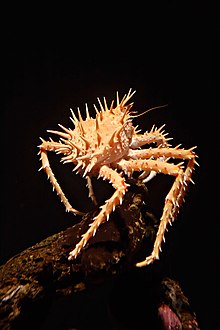| Paralithodes Temporal range: | |
|---|---|
 | |
| Paralithodes californiensis | |
| Scientific classification | |
| Domain: | Eukaryota |
| Kingdom: | Animalia |
| Phylum: | Arthropoda |
| Class: | Malacostraca |
| Order: | Decapoda |
| Suborder: | Pleocyemata |
| Infraorder: | Anomura |
| Family: | Lithodidae |
| Subfamily: | Lithodinae |
| Genus: | Paralithodes Brandt, 1848 |
| Type species | |
| Paralithodes brevipes (H. Milne-Edwards & Lucas, 1841) | |
Paralithodes is a genus of king crabs native to cold waters in the North Pacific Ocean, Okhotsk Sea, Bering Sea and Sea of Japan, but with one species also introduced to far northern Europe. They are medium-large to very large king crabs, and some species are important to commercial fisheries. [1] A 2017 examination of the phylogeny of king crabs suggests that the internal placement of Paralithodes within this family is not fully resolved. [2]





